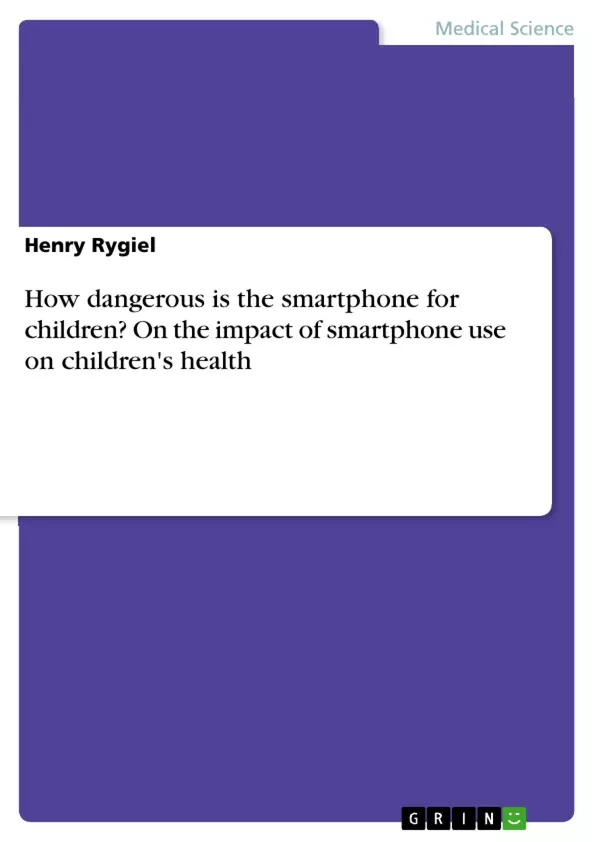Smartphones are now everything in one: telephone, address book, search engine and games console. In the meantime, they have become an integral part of our lives, which can also be found in children's rooms more and more often. But how does smartphone use affect the health of young children?
In order to answer this question, Henry Rygiel evaluates various national and international studies in his publication. He determines the risk potential of smartphones and shows what they can do to the development of preschool children.
Behavioral and language development disorders are just as likely as addictive behavior. Precisely for this reason, prevention must start as early as possible, preferably in the day-care center and of course in the family itself. Although children cannot avoid digitization, they can learn to deal with it properly.
From the content:
- Health hazard;
- Media usage;
- Children;
- Prevention;
- Mobile phone
Inhaltsverzeichnis (Table of Contents)
- 1 Introduction
- 1.1 Context of origin, personal motivation
- 1.2 Brief overview media
- 1.3 History Smartphone
- 1.4 Problem statement
- 2 Questions and hypothesis formation
- 2.1 Media
- 2.2 Hazard potential
- 2.3 Socio-demographics
- 2.4 Other
- 2.5 Hypothesis formation
- 3 State of research
- 3.1 Study situation
- 4 National Studies
- 4.1 2014 - miniKIM - Study
- 4.2 2015 - Digital Milieu Study DIVSI - U
- 4.3 2016 - FIM - Study
- 4.4 2017 - BLIKK - Study
- 4.5 Conclusion of the national studies
- 5 International Studies
- 5.1 Patterns of mobile device use by care-givers and children during meals in fast food restaurants
- 5.2 Maternal mobile device use during a structured parent-child interaction task
- 5.3 Exposure and Use of Mobile Media Devices by Young Children
- 5.4 Influence of smartphone addiction proneness of young children on problematic behaviors and emotional intelligence: Mediating self-assessment effects of parents using smartphones
- 5.5 Parent Perspectives on Their Mobile Technology Use: The Excitement and Exhaustion of Parenting While Connected
- 5.6 Mothers' views of their preschool child's screen-viewing behavior: a qualitative study
- 5.7 The Relation Between Use of Mobile Electronic Devices and Bedtime Resistance, Sleep Duration, and Daytime Sleepiness Among Preschoolers
- 5.8 Touchscreen generation: childrenâs current media use, parental supervision methods and attitudes towards contemporary media
- 5.9 Parent Perceptions of Mobile Device Use Among Preschool-Aged Children in Rural Head Start Centers
- 5.10 Electronic Media Exposure and Use among Toddlers
- 5.11 Childrenâs Environmental Health in the Digital Era: Understanding Early Screen Exposure as a Preventable Risk Factor for Obesity and Sleep Disorders
- 5.12 Conclusion of the international studies
- 6 Tabular comparison of the studies
- 7 Hypothesis matching
- 8 Results with regard to preventive services and measures
- 9 Conclusion
- 9.1 Discussion
- 9.2 View
Zielsetzung und Themenschwerpunkte (Objectives and Key Themes)
This paper aims to explore the impact of smartphone use on children's health by analyzing recent national and international studies. The focus is on examining the use behavior, potential health effects, and consequences for children. The research investigates the increasing prevalence of smartphone use among preschoolers and its implications for their development.
- The influence of smartphone use on children's health and development
- The role of parental smartphone use in shaping children's media consumption and behavior
- The potential health consequences of excessive smartphone use in young children
- The impact of smartphone use on children's communication, leisure activities, and social interactions
- The importance of preventive measures and services to mitigate the negative effects of smartphone use
Zusammenfassung der Kapitel (Chapter Summaries)
The introduction establishes the context and motivation for the research, providing a brief overview of media and the history of smartphones. The paper then defines the problem statement, outlining the research question and the formation of hypotheses. The state of research section provides a comprehensive overview of the study situation.
The national studies section delves into four key studies conducted in Germany, focusing on media use and its impact on children. This section analyzes the findings of each study, highlighting key insights and trends. The international studies section explores a variety of research papers from different countries, examining various aspects of smartphone use in preschool children, including parental perspectives, screen-viewing behavior, sleep patterns, and potential risks to children's health.
The paper continues by presenting a tabular comparison of the studies, highlighting the similarities and differences in their findings. Subsequently, it examines how the research results align with the previously formulated hypotheses.
Schlüsselwörter (Keywords)
This research paper focuses on the impact of smartphone use on children's health, specifically in the context of preschoolers. Key terms and concepts explored include media use, smartphone use, children's development, health effects, parental influence, addictive behavior, communication, leisure activities, and preventive measures. The study draws upon findings from national and international studies, highlighting the significance of early screen exposure as a potential risk factor for various health issues.
- Arbeit zitieren
- Henry Rygiel (Autor:in), 2019, How dangerous is the smartphone for children? On the impact of smartphone use on children's health, München, GRIN Verlag, https://www.grin.com/document/1185098



